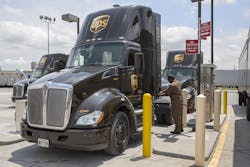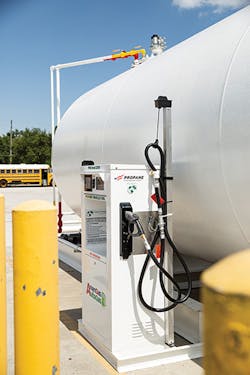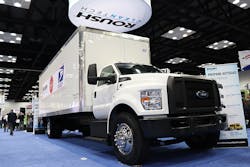At the Work Truck Show’s Green Truck Summit in Indianapolis this past March, emcee John H. Davis, who has hosted and executive produced the PBS program "MotorWeek" for nearly 40 years, pointed to California’s recent regulations on truck emissions as some of the preeminent omens affecting the future of fleets’ operations and bottom line. He also emphasized how fleets will need to re-examine how they approach more stringent regulations and increasing public scrutiny.
“The challenge for every fleet—no matter how small—and every manufacturer is to get ahead of these mandates for new technologies using alternative fuels,” Davis said. “And I don’t mean just electrification either. As we all know, there is no one-size-fits-all when it comes to alternative fuels and commercial trucks.”
The feature on page 52 details upcoming zero-emissions options, but due to industry complexities and the lack of charging infrastructure, that path isn’t the quickest route to a cleaner fleet. If the immediate goal is to arrive at upcoming environmental regulations ahead of schedule, fleets may want to consider merging onto the alternative fuel fast lane and adopt oft-overlooked clean technologies, such as compressed natural gas (CNG) and propane autogas engines. Utilizing these where possible and financially feasible can address air quality and total cost of ownership issues right now, accelerating fleets into a cleaner future.
The regulators
What the nation is really facing is a thick, smoky wall blocking it from achieving the idyllic atmosphere the world should have in 2020, considering all the available technology.
According to California Air Resources Board (CARB), it’s a barrier that creates an unhealthy atmosphere that 90% of state residents must inhale, a reality the public will find impossible to swallow in the midst of the COVID-19 pandemic that feasts on weakened respiratory systems.
Last fall, California Gov. Gavin Newsom signed a smog check bill into law that will force trucks older than six years with a gross vehicle weight rating of 14,000 pounds to get checked before operating in the state. CARB will lead the program after a two-year pilot. Another bill signed at the same time pushes for the Golden State to phase out diesel-powered trucks by 2050.
California also has the proposed Advanced Clean Trucks (ACT) Regulation, which would mandate 3% of model-year 2024 Class 7 and 8 trucks sold in the state to be zero emissions vehicles (ZEV) and 15% by 2030. This is in an effort to reduce greenhouse gas (GHG) by 40% and drop petroleum by 50%, with 2030 as the target date for both. The rule is stricter for refuse and delivery trucks, with 7% in 2024 and 50% by 2030. A decade later, 100% of commercial trucks would be zero emissions.
The reason for the moves was to mitigate the impact of trucking emissions, which accounts for 7% of California traffic but contributes 20% of the GHGs and 40% of the particulates that create smog. Geography also plays a major role, but regulating the trucking industry is far easier than moving mountains. The state has special permission via waivers to enforce emissions standards beyond federal rules, as per the Clean Air Act .
Davis theorized that if what is happening in California succeeds, the rest of the country could follow.
Stricter national standards are already in the works. The U.S. Environmental Protection Agency (EPA) is in the early stages of developing the Cleaner Truck Initiative (CTI) to update emissions standards for heavy-duty trucks to reign in nitrogen oxide (NOx) and other pollutants. Earlier this year, the regulatory body solicited pre-proposal comments from the public and relevant stakeholders.
“Through this initiative, we will modernize heavy-duty truck engines, improving their efficiency and reducing their emissions, which will lead to a healthier environment,” said EPA Administrator Andrew Wheeler.
Sustainability and responsibility
While Davis indicated fleets of any size can adopt alternative fuels, common sense dictates that big fleets with higher capital and more trucks to collect data will lead. And many are not waiting for governmental guidance, which can change swiftly after the 2020 U.S. election cycle.
If a Democrat wins, be it former Vice President Joe Biden or another candidate, he would most assuredly take a harder stance on climate policies than President Donald Trump.
“Companies are striving to be better caretakers of the community and environment,” said Michael McDonald, UPS director of sustainability and government affairs, at the Green Truck Summit panel on alternative fuels.
McDonald stated he believes there is a correlation between the environment and human activity.
It’s hard not to argue the world is bearing witness to the tangible, visceral effect human-generated emissions have had on urban populations while everyone is ordered to self-isolate during the current pandemic. Los Angeles is enjoying its cleanest air since 1995, with quality improving 20% from March 16 to April 6, according to UCLA’s Fielding School of Public Health. In an even more dramatic scenario, the residents of Punjab, India, could view the Himalayan peaks from their north-facing windows for the first time since 1990.
It’s harder still to make the case for business as usual.
As of 2017, medium- and heavy-duty trucks accounted for 7% of GHG emissions in the United States, according to the EPA. That may not seem like a significant number at first, but some may argue when those city-sized smog saucers return, any amount will seem too much. With the uptick in e-commerce and more delivery trucks heading into densely populated urban areas, the call for zero-emissions trucks will intensify.
Earlier this year, UPS ordered 10,000 electric box trucks made by Arrival, which will be tested in London and Paris and rolled out in North America over the next four years.
Those aren’t widely available yet and do come with infrastructure and capital expenditure caveats, clearing the way for near-zero emissions alternatives to “bridge the gap” between gas and diesel and battery electric and fuel cell fleet vehicles, according to McDonald.
“For folks who are struggling with what to buy and when to buy it, just know that there is an area between when you start and when you finish. There are things in the middle that you can look to,” McDonald said.
UPS’s private fleet comprises 125,000 vehicles, with around 9,100 vehicles in America using alternative fuels and/or advanced technology, on which it has invested more than $1 billion in the last decade. Starting this year, the company vowed that one in four new trucks will add to that number of clean trucks. In what UPS refers to as a “rolling laboratory” approach, the logistics provider routinely tests new prototypes as old vehicles are phased out.
“Because we have such a large fleet, we have the ability to take chances, but they’re measured risks,” McDonald explained. “We do look at money, and we do look at the return on investment, so we don’t just throw things against the wall and hope it works.”
UPS has used propane since 1982 and currently runs 1,175 of its vehicles on propane. In 1989, the fleet began using compressed natural gas (CNG). Now, more than 5,100 vehicles are equipped with CNG. Under an exclusive deal with Agility Fuel Systems, UPS has committed to purchase another 6,000 natural gas-powered trucks by 2022.
Infrastructure is vital to any operation, and as of 2019, UPS had 61 CNG stations in the U.S. These stations will be able to run on renewable natural gas (RNG), or biomethane harvested at dairy farms and landfills. RNG is said to be 90% more effective at cutting life cycle greenhouse gas emissions compared to conventional diesel. UPS has a contract to buy about 250 million gallons of renewable fuel.
McDonald stressed the importance of fleets doing their homework and deciding which source works best for them.
Compressed Natural Gas (CNG)
Hobart, Ind., a city of 30,000, has been using CNG-powered refuse trucks for six years and has five municipal vehicles. In 2018, the city built a CNG fueling station and vehicle maintenance garage at its Public Works facility. Previously, drivers would have to travel 14 miles northwest to CNG provider Ozinga’s ready mix concrete plant, which has a public CNG fueling station. Ozinga installed and maintains the Hobart station as well.
Hobart Mayor Brian Snedecor said investing in the clean technology was part of a transition from an identity as a “blue-collar, sleepy bedroom community to a progressive community leading the way.”
A Congestion Mitigation and Air Quality grant from the Federal Highway Administration covered 80% of the $2 million project.
“We’re talking 40 cents a gallon for CNG fuel versus over $3 a gallon for diesel fuel,” said Hobart Public Works Director John Dubach in 2019. “Our financial savings sure made this idea a lot easier to sell.”
Along with providing fleets with CNG components, Ozinga uses the abundant resource in its own fleet of concrete mixers. Annually, the company replaces 165,000 diesel gallons a year with CNG and plans to up that to 800,000 gallons a year by 2025.
Overall in the space, manufacturers are planning several years ahead, so fleets that invest now will still be compliant at the end of the decade. Following the Green Truck Summit, equipment manufacturer Cummins Westport unveiled the next generation of its B6.7N engine, which can use CNG, liquid natural gas and RNG. The engine for medium-duty trucks and buses was engineered to meet the optional low NOx standard of 0.02 g/bhp-hr., making it compliant with 2021, 2024, and 2027 GHG Phase II emissions requirements.
Propane
Cummins also has a B6.7 propane engine in the works, using diesel parts where necessary.
“We’ve created a direct-injected engine that is off the charts in many ways,” said Tucker Perkins, president and CEO of the Propane Education & Research Council (PERC), which collaborated with Cummins on the project for the last five years. “That’s the engine we’ve been waiting for to begin to breach the Class 8 market.”
Perkins noted the engine had precise control of the air-fuel mix and higher compression ratios, as well as brake thermal efficiency (BTE) that approaches diesel. “That’s monumental for us; that’s been our Holy Grail,” he said of the BTE.
Globally, 26 million vehicles run on propane, with 260,000 units running on propane in the U.S., according to PERC.
Perkins said a return on investment of three years has typically been the selling point, but the emissions reductions are becoming more important.
“We love it when people want to talk about a 0.05 standard for their NOx,” he said. “We do that with a simple three-way catalyst and [with] almost every engine, we can do ultra-low NOx.”
Perkins added that public image is another concern for fleets and reason to choose a near-zero emissions truck: “When you deliver water, you’re in the crosshairs of a lot of environmentalists, so you need to worry about your brand, your image, your sustainability score.”
Roush CleanTech has found many benefits working with the fuel, with 20,000 propane trucks on the road. That’s according to the engineering company’s president Todd Mouw, who spoke to FleetOwner at the Work Truck Show exhibit hall.
In 2006, Roush started to work with Ford to develop propane engines as well as natural gas and hydrogen fuel cell.
“We can pack a lot of fuel on board.There’s no compromise to power and torque, and the infrastructure is relatively easy to put in,” Mouw explained. “It’s a no-compromise solution.”
Roush’s ultra-low NOx engine is 0.02 g/bhp-hr., and renewable propane will drive the carbon intensity down even further, he said.
Mouw echoed McDonald’s sentiment on the role of alternative fuels and why battery-electric cost and infrastructure align better on the business side.
“This is a really nice bridge piece until we get to something utopian, whether that’s hydrogen or electric,” Mouw said.
South Carolina-based McAbee Trucking, which has had a U.S. Postal Service (USPS) contract for almost 50 years, is the first postal contractor to implement propane, according to Lisa McAbee, who owns the business along with her husband. In April the fleet received the first of eight Ford F-750 delivery trucks equipped with Ford 6.8L V10 engines and Roush CleanTech propane fuel systems. The configuration comes in at 90% cleaner than the EPA’s most stringent heavy-duty emissions standard, reported Roush CleanTech.
In 2017, McAbee received its first two CNG trucks and added four more this year. Her research, which included vetting the Propane Education & Research Council’s website, reading about Roush, and checking safety, led her to believe propane could provide better total cost of ownership.
“The cost for compressed natural gas versus propane trucks is about 40% more, and the infrastructure for getting your own filling station is a lot easier than any other station for commercial natural gas,” McAbee explained.
McAbee will have three trucks in North Carolina and five at the home base in Blacksburg, S.C., which will also have a propane fueling station.
Perkins said installing a propane station, comprising the tank, motors and pump, is about $60,000.
“If you work with the gas suppliers in America and all the other propane dealers out there, sometimes you can get a system for nothing as incentive for using their propane,” McAbee noted.
Ultimately, McAbee said the approval of the driver who tested the truck influenced the decision to go propane.
“I liked the pickup on it, and it takes off a lot quicker than a diesel truck does,” said driver Doug Zucker, who runs 80-mile routes. “And I like the sustainability factor of it.”
About the Author
John Hitch
Editor
John Hitch is the editor-in-chief of Fleet Maintenance, providing maintenance management and technicians with the the latest information on the tools and strategies to keep their fleets' commercial vehicles moving. He is based out of Cleveland, Ohio, and was previously senior editor for FleetOwner. He previously wrote about manufacturing and advanced technology for IndustryWeek and New Equipment Digest.




